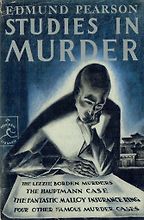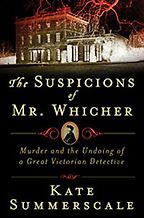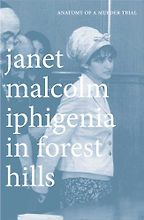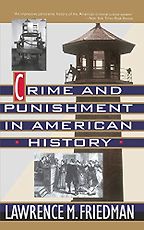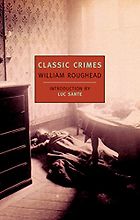What makes a good true crime book?
It helps to have an element of mystery. In the books that I chose, I’d say the solution seemed unsatisfactory, either because there’s just no real resolution to the criminal justice process or because the motive is opaque. All of the books I chose involve cases where there seems to be something larger at stake than the fate of the individual defendant. These cases are hard to pin down. They’re provocative, and they open up larger questions about justice that are often never fully answered.
This is why I wanted to choose one of Lawrence Friedman’s books. Inevitably, in any successful true crime book (particularly that of a murder and the ensuing trial), much is made of the individual psychology of the accused. We ask ourselves, ‘Is this the sort of person who could have done such a thing?’ By the end of the book, readers should either have an answer to the question, or understand the reasons for their hesitation.
By contrast, Crime and Punishment in American History is a social history with a necessarily wider scope. It’s about the way that our attitudes towards crime change over time, changes that reflect society at large, as opposed to a focus on one horrific violation of the norm.
You mentioned that these stories are compelling because they’re preoccupied with questions of whether or how individuals can commit heinous acts, such as murder. You’ve just written a book on Lizzie Borden. For readers who don’t know, can you tell us about that crime and the ensuing trial?
Lizzie Borden was a 32-year-old, unmarried woman living in the then-prosperous mill town of Fall River, Massachusetts who was accused of killing her father and her stepmother with a hatchet on an otherwise unremarkable August morning in 1892.
“The murders were so violent that some speculated that Jack the Ripper might’ve come to America.”
The murders were so violent that some speculated that Jack the Ripper might’ve come to America. Yet the woman who was accused was someone who ticked all the boxes of respectable, middle-class femininity. She was unmarried and living in her father’s house, as I mentioned. She was engaged with the pursuits of a woman of her class at that time—she was active in her local church; she was even a Sunday school teacher. The incongruity of such a person committing such a brutal crime turned the case into a cause célèbre, the trial of the nineteenth century.
Your first choice, Edmund Pearson’s Studies in Murder (1924), calls the Borden case “the most interesting, and perhaps the most puzzling murder which has occurred in this country”. Why does he say that?
Pearson is both referring to the tight timetable of the murders, the near impossibility of outsider managing to commit the murders while avoiding the survivors of the day (Lizzie Borden and the maidservant Bridget Sullivan) and, at the same time, the practical difficulty of Borden herself killing both stepmother and father without leaving any trace of the carnage on her person. More than that, he is struggling with the idea that someone like Lizzie Borden, the apparent epitome of feminine respectability, could have committed the hatchet murders of her father and stepmother.
Nonetheless, Pearson is quite convinced she did it. As befits someone who started out as a humorist—he was also a librarian before he turned to writing true crime—he has a real eye for the odd details in the Borden case. For example, he memorably describes the depressing bill of fare—leftover mutton and mutton stew—which makes for quite a delightful read. The humor has a distancing effect, mitigating the horror.
Chronologically, the choices on your list begin quite early. Is the Lizzie Borden case the beginning of true crime reportage as we know it, of trials being sensationalized in America?
Sensational accounts of murder were perennially popular and fueled the circulation wars of yellow journalism in the latter part of the nineteenth century. So the timing is right: the stage is set for a trial like Lizzie Borden’s to capture the national imagination. One could argue that the Borden case as one of the first examples of the trial as a public spectacle, a sort of celebrity trial. Obviously, Lizzie Borden is not herself famous before the crime. She’s actually quite unremarkable, and a bit unreadable, which is part of the reason she’s such a compelling figure.
“He is struggling with the idea that someone like Lizzie Borden, the apparent epitome of feminine respectability, could have committed the hatchet murders of her father and stepmother”
Many people now talk about the ‘renaissance’ or the ‘boom’ in true crime writing. I thought by choosing the early writers—William Roughead and Edmund Pearson—I could show that the higher-brow (or middlebrow, at least) writing about crime started earlier than we usually think.
The Borden case, incidentally, comprises only one essay in Pearson’s book. Why does he go on to have this fascination with why people commit horrible crimes?
He once wrote—I’m paraphrasing here—that basically eight of any ten people are interested in murder, and the other two are lying. He has a sense that this is a subject people find really interesting, and he describes himself as a “murder fancier.”
Get the weekly Five Books newsletter
Most of his analyses are of what you might call historic crimes—crimes that have already happened—so that he can tell you the story not only of the crime, but also its resolution or irresolution. Interestingly and unusually, Lizzie Borden was still alive when he began writing about her. On the one hand, it’s a historical case—almost 30 years old—but the protagonist, if you will, is still alive. He becomes quite interested in her as a figure and even lurked outside her post-acquittal manse in Fall River on one occasion, hoping for a glimpse of his subject.
Your second choice is Classic Crimes by William Roughead. Can you tell us a bit about this book, and why you chose it?
William Roughead technically pre-dates Pearson. He began writing at the beginning of the twentieth century, but he struck up a correspondence and friendship with Pearson after the publication of Studies in Murder in 1924. Roughead was a Scottish lawyer. He started out as what you’d call an amateur criminologist. He edited a notable British trial series, and he himself attended most of the significant trials that happened in Scotland during his lifetime.
I picked that particular book because it collects some of his best stories and also because it’s still in print, so I thought it would be the easiest for people to get a hold of, which I heartily recommend!
How would you characterize his style of crime writing?
Ornate. He’s a friend of Henry James, and some have said he has a Jamesian style. To me, he’s more reminiscent of Henry Fielding. He’s an extremely intrusive narrator. He’s quite happy to go on digressions, and he uses involved, sometimes archaic language. He’s interested in pinning down as much as he can figure out about the people as people, the personalities involved in the stories. You definitely have a sense of his presence in the work as someone showing you or telling you the story. You can imagine being in front of a fireplace and hearing a slightly longwinded, but really riveting tale.
Who was his audience at this time? Was it the newspaper reading public, or is he writing more, like Pearson was, for a middle-brow or high-brow audience?
I’d say the latter. He was interested in the subject long before he started writing for commercial publication. He and Pearson share a correspondence, which is, as befits them, very entertaining. They’re both quite urbane characters. They are also dismissive of what they see as more of the lowbrow true crime writers. They mention a few contemporaries of theirs a bit snidely.
How does gender play into this? To me it’s very ‘Victorian men of letters discussing abstractions or natural phenomena’.
That’s right. It’s not a coincidence that one of the writers they disparage is a woman. They clearly view Lizzie Borden as an intriguing and titillating figure. Roughead refers to Pearson’s “attaching tale of the incomparable Lizzie Borden”, and says to him in a letter at one point, “if I were a bachelor, instead of a bald-headed father of four, I should visit Fall River and pay my addresses to the attaching Miss Lizzie, on the chance of getting something out of her regarding the case in the privacy of domestic life.”
That’s really odd. It’s hard to imagine Janet Malcolm saying that about anyone.
[Laughs.] Absolutely not. It is very striking—both patronizing and a bit prurient.
I remember being surprised while reading Iphigenia in Forest Hills by a scene in which she’s visiting the victim’s family at their home—I don’t know if it struck you as well, but I’d forgotten it the first time around. The kids pop in from the periphery, and Malcolm’s trying to figure out what the kids might say, and she puts her arm casually around one of them. Entirely natural gesture, but somehow inconsistent with her authoritative persona. I read it and thought, ‘Oh my god. Janet Malcolm just put her arm around a kid!’
Yes! And she even goes on to intervene with the entry of a prosecution witness. In a phone call with Malcolm, a court appointed guardian unloads all sorts of insane conspiracy theories about the US government. She hangs up and writes, “Then I did something I have never done before as a journalist. I meddled with the story I was reporting. I entered it as a character who could affect its plot. I picked up the phone and called [Judge] Stephen Scaring’s office.”
That’s, of course, the serious intervention in the story and demonstrates just how unbalanced she found the guardian. It also struck me, reading it again, that the guardian’s crazy beliefs are more mainstream now, which is horrifying. The list of things that are clearly an indication that he’s not a rational thinker are things that unfortunately one can find quite easily on the internet these days.
We’d normally associate true crime of the past with the era of sensationalized story—with an absence of rigorous fact-checking, and fake news—but it seems like that’s just as present today as ever.
Yes. Perhaps Pearson is onto something when he says that there’s something about the subject matter that just interests people and the sensationalized, breathless approach will draw the eye. Yet there was also an audience for tales told in a more leisurely and careful manner. Pearson and Roughead were professional men of learning who sought tell the stories accurately and artfully. Their background is part of their calling card.
“Pearson and Roughead were professional men of learning who sought tell the stories accurately and artfully”
They’re also standing in opposition to very schematic, nineteenth-century views of criminality, where it wouldn’t have been that difficult to fathom why someone did something because criminals had ‘a type.’ According to the influential criminologist Cesare Lombroso, you could see the signs of criminality in someone’s face.
Pearson actually makes a lot of fun of that notion. In The Instigation of the Devil, he includes, among his studies of crimes, a few lighter essays like “Rules for Murderesses”, “What Makes a Good Murder?” and “What Does a Murderer Look Like?” He points out that many of the same features that are supposed to be indicative of the criminal type are equally visible in undergraduates at Cambridge and Oxford.
Is that meant to debunk the idea that criminals can be visually typed, or suggest that any of us could be criminals?
That’s a good question! I suppose it could be either. But I think he intended to mock the notion of a biological type as an outdated view —in other words, that was the idea of a benighted era, and now of course we’re much smarter. Pearson is intrigued by individual psychological understandings; he’s right at the beginning of the psychoanalytic era.
So, he’s right on the cusp of Freudian psychoanalysis. And even figures like Lizzie Borden, say, come just before the advent of widespread fingerprint analysis as a forensic investigation technique in crimes. Do we see these developments in your choices?
They do have that in common. Some of these cases, you would think, could be easily resolved with techniques of forensic analysis we have now. But I’d hesitate to say that, because these books highlight cases hinging on whether a jury can believe that the defendant was capable of the crime—not so much the mechanics of it. That’s very clearly what’s going on with Lizzie Borden, but to a certain extent that’s at play in any trial. We say there’s evidence linking a person to a crime, even proving that the accused must be involved—but do we really think that person could have done it?
Your third true crime book is by Kate Summerscale, The Suspicions of Mr. Whicher. Tell us about this one.
This is a completely gripping book that looks at a notorious Victorian murder case, often referred to as the Road Hill House case, involving the murder of the young boy, apparently taken from his bed, one night in 1860. A search for the missing boy, the product of his father’s second marriage, results in the discovery of his corpse in an outdoor privy. A central figure is a man named Jonathan Whicher, one of Scotland Yard’s first detectives, who influenced writers like Charles Dickens and Wilkie Collins. The book examines the interplay between literature and the historical circumstances of this case.
Summerscale writes that the case is modelled on what we think of as the “classic country-house murder,” which is “an assault on propriety, an aggressive exposure of base needs and desires.” This is a template familiar to us through many of the later Golden Age detection fiction books, including the works of Agatha Christie. In other words, there’s a house with secrets; there are a limited number of suspects; there’s the possibility of a Mr. X from the outside; but really, in all likelihood, somebody in the house must be responsible.
Five Books interviews are expensive to produce. If you're enjoying this interview, please support us by donating a small amount.
Summerscale manages to balance the psychological dynamics of living in a house with many secrets and tensions in the Kent family and the mechanics of the crime solving plot, exactly where are the different members of the household at critical moments. So the story zips along, drawing out the central mystery, without sacrificing psychological depth or historical context. By comparison, Roughead writes a story about the same case focused on Constance Kent (who, spoiler alert, eventually confesses to the murder of her half-brother), and he lets you know right at the beginning of the story that she’s the murderer, simply because he can’t resist a slightly convoluted joke. And, unlike Summerscale, who suggests that she may have been protecting someone else in the family, he doesn’t admit any doubt or uncertainty in the solution.
Bit of a chicken and egg question, but do we see these real-life cases influencing the way crime is written about in fiction, or do the kind of crimes typified in Victorian fiction (the country house murder, and so on) start to become the ones singled out for sensational press coverage?
It’s a really interesting question. One of the many terrific features of The Suspicions of Mr. Whicher is that Summerscale points out the influence of this case on Victorian fiction. She notes that some of the relationships in the house seem to influence Dickens later. There are definite echoes: the relationship between Constance and her brother William is much like the siblings in The Mystery of Edwin Drood, and there are a number of features which seem to influence Collins’s The Moonstone as well.
There’s no doubt that Dickens and Collins took plot details from sensational true crime cases to put in their novels. But there are also certain themes that have a universality to them and therefore have an appeal that makes for good newspaper fodder. Though there’s no good reason to kill someone, we understand some common motives. For instance, in this book, there are the jealousies at play between the father’s first family and the second with the convenient figure of the governess turned ‘evil’ stepmother. It’s no coincidence that it captures the imagination.
“There’s no doubt that Dickens and Collins took plot details from sensational true crime cases to put in their novels.”
To a certain extent in these cases, and in the true crime books they spawn, the success in explaining the murder comes from fitting either the perpetrator or the victim—or both—into these readily available tropes, as opposed to seeing them in their particularity.
One person on your list who really does see people in all their particularity is Janet Malcolm. You picked Iphigenia in Forest Hills, which isn’t her first book about a trial or even her most famous (The Journalist and the Murderer). Why did you pick this one?
I knew I wanted a Janet Malcolm book, and I was deciding between this one and The Journalist and the Murder. Ultimately, I thought this one fit better with the rest of the books, first because the defendant is female—another woman on trial—and also because, as Malcolm herself says of the defendant, she couldn’t have done it, but she must have done it. In a number of these cases, there’s this same difficulty in accepting the obvious solution. Like both Lizzie Borden and Constance Kent, the defendant in Malcolm’s book is an enigma. Moreover, that enigmatic quality allows the prosecution to paint her in a manner consistent with the worst, or most damning, female stereotypes, so that she becomes easier to convict.
Malcolm’s style is so different from the other writers I’ve chosen. It’s so distilled; there isn’t one extra word. That’s certainly not the case with someone like William Roughead, but it’s part of the pleasure of both—they’re on different ends of a spectrum.
I found it fascinating how Malcolm took everyday procedures of the justice system and exposed their artificiality. At one point, she writes, “If any profession (apart from the novelist’s) is in the business of making things up, it is the profession of the trial lawyer.”
Part of why I’m interested in trials is you have a very clear illustration of what sort of stories are persuasive to people. The prosecution and the defense each tell a story designed to convince a group of people, who are themselves specifically chosen to represent society at large. It often gives you a sense of what’s at stake in these prosecutions, beyond the fate of the individual defendant. You see the anxieties of a particular time and place and also what’s taken for granted, and doesn’t need to be spelled out.
Malcolm herself seems aware of the way that narrative is used in trials to seduce a jury; say, to play on certain stereotypes to make a female defendant look bad.
The story often has to be oversimplified to fit the constraints. The examples that I’ve chosen, either through because of their historical background or a depiction of psychological complexity, all show that it’s not such a simple story. What appealed to me about Iphigenia in Forest Hills was how Janet Malcolm points out the artificial constraints of the trial.
Typically, the focus would be on how the prosecutor’s or the defense lawyer’s choices lead to the verdict. But Malcolm is really attuned to the way in which the judge is shaping the outcome as well. This particular judge seems to have very specific motivations—there’s a question of whether he really just wants it all to be done so he can go on a planned vacation, which is a little horrifying.
“Malcolm shows how the judge, ruling by ruling, is tilting the case against the defendant.”
But much of what Malcolm illuminates about this trial is true, in a less pronounced way, in every case. This one is just a strikingly bad example of things going off the rails. For instance, the judge insists that the defense lawyer give his summation on a Friday, rather than permitting him the necessary respite over the weekend to prepare his argument. It shows in the lawyer’s performance and seems like such a punitive decision given the stakes.
But before that, she shows how the judge, ruling by ruling, is tilting the case against the defendant. Ideally, when we think of the judge as gatekeeper, who decides what evidence the jury will hear, we imagine it’s a straightforward application of the law to the facts of the case. But of course, even when judges don’t have particular agendas—as it seemed like the judge might have in this particular case—they’re inevitably making their decisions in a specific context. They must balance the probative versus the prejudicial value of evidence. They have to be attentive to what the jurors might think and they can’t make that determination without an idea of what the prejudices or the stereotypes might be. There’s a question of what feeds into a stereotype that is far from simple or reductive. It’s uncomfortable see that operate, I think.
Do you think that creates a constraint for the true crime writer—who’s necessarily weighing up facts and details selectively—as well?
In a way, it’s similar to writing any kind of non-fiction. What details the writer selects, how those details are presented all influence the reader in ways that may not be self-evident. For example, there is something hypnotic about Malcolm’s style so that it is impossible to imagine taking a different view of the events she narrates.
Your last book is Lawrence Friedman’s Crime and Punishment in American History. You already spoke a little bit about it at the outset, but tell us more.
Lawrence Friedman’s book is a panoramic social history of our criminal justice system from the colonial times to the end of the twentieth century. It shows how changes in the definitions of crime and the contours of the criminal justice system mirrored society. What we choose to criminalize and how we view the seriousness of those crimes, judged by what we designate as punishment, is a social construction. It’s a reflection of its era.
In many ways, this last book is a framework for all of the true crime books you selected before it.
Yes. I thought it would be good to pick a book that was a much wider lens than the studies of individual cases. Also, although his work is academic, Friedman writes in a style that is as accessible and as witty as any of the other writers that I have chosen. His work is not about the individual psychology of any particular crime; it’s about the way in which particular crimes speak to an era.
Do you think this is a necessary read for anyone addicted to the ‘true crime’ genre, whether through books or Netflix dramas like Making a Murderer?
Yes. It’s a good idea to have a context in which to place the specific cases. Much of the time when you’re dealing with a particularly famous trial—say, that of Lizzie Borden—the amount of press attention, legal talent, and actual time is so different than would be expended in a more ordinary case. I think it’s worth having a sense of what the norm is, so you can see the way in which these cases deviate from it. It explains why they’re significant, and what makes them different.
Get the weekly Five Books newsletter
This is one problem identifiable across all of the choices we’ve discussed, except perhaps the Malcolm book which she reports closer to ‘real time.’ Most of the books deal with particularly sensational crimes, chosen by writers who have a historical vantage point and can assess which crimes merit sustained study.
We’ve been talking about how particularly famous trials become immortalized through an enduring morbid fascination. At the same time, my parents sang me that Lizzie Borden nursery rhyme to put me to sleep when I was a child. Has the fascination with true crime been normalized and made entertainment? Or is it always in some way deeply discomfiting and grotesque?
I think we’re fascinated by the taboo and prefer it at a safe remove. Pearson’s wry humor, for example, creates a distancing effect from the horror. It allows the reader to enjoy it in a way that you wouldn’t if you focused, as Truman Capote does in In Cold Blood (a classic of this genre), on the story of the victims’ ordinariness and the perpetrators’ sad histories. In terms of the entertainment quotient, distancing is critical.
Capote describes In Cold Blood as a ‘non-fiction novel’ and it is often considered an elevating moment, the turning point for the genre that had been seen as déclassé. As I’ve noted, prior writers produced work that was artfully composed, featuring intriguing characters with depth. But In Cold Blood is novelistic because you feel deep empathy for the characters in a way we associate with fiction. He’s probably not so reliable as a nonfiction writer for that reason, despite his immersion in the case.
Did you find yourself empathizing with Lizzie Borden at all?
I empathized with all of the characters in the sense that I thought it would be awful to be trapped in that house. There’s a suffocating tension in the household. If anything, I felt most sorry for the stepmother, who is invoked as the reason for the murders but is otherwise completely absent from the story. She figures only as this mythic evil stepmother type, who has somehow come between father and daughter. Yet there’s no real evidence that she was at all like that as a person.
“There’s something deeply uncomfortable about the idea that a woman would act with such violence, even today”
In many of these really well-done, carefully paced, deeply researched stories, which focus particularly on someone who’s been wrongfully convicted (true crime Netflix dramas, or a podcast like Serial, for example), the victim is pretty much removed from the story. Obviously, there’s no incentive for the victim’s family to participate in the making of the documentary because they think the correct person has been found guilty. And, of course, the victim is not there to speak for him or herself. You don’t get to know them in the way that you get to know the accused.
What have you learned as a true crime writer? As you were writing the Lizzie Borden book, doing all that archival research, what did you learn about women who kill, or human nature in general?
I think what I’ve learned is that the discomfort remains. It’s easy to dismiss, as many have done, the jury’s verdict in Lizzie Borden’s case as a false gallantry and a late Victorian blindness about women’s capacity to commit violence—at least when speaking of outwardly respectable middle-class women. But I think there’s something deeply uncomfortable about the idea that a woman would act with such violence, even today. And not simply because the accused was a woman who seemed, at least on paper, to be the epitome of upper middle-class feminine virtue.
Five Books interviews are expensive to produce. If you're enjoying this interview, please support us by donating a small amount.
My own unease centers on her ordinariness. Because we have the advantage of hindsight, we know that not only did Lizzie Borden live a pretty normal life before the murders, but we also know that she lived a fairly ordinary life after the murders. Many people at the time thought that she was a kind of human sphinx, an unreadable cipher, onto whom they could project their fears about the biological evil under the civilized veneer of femininity. But perhaps she was just an otherwise ordinary person and one wonders whether that is true of many people at the center of terrible crimes.
Five Books aims to keep its book recommendations and interviews up to date. If you are the interviewee and would like to update your choice of books (or even just what you say about them) please email us at [email protected]


